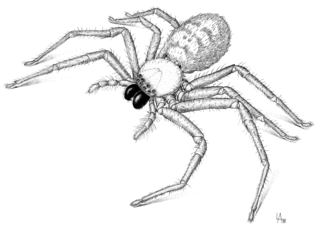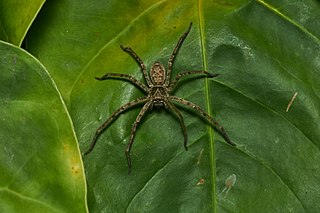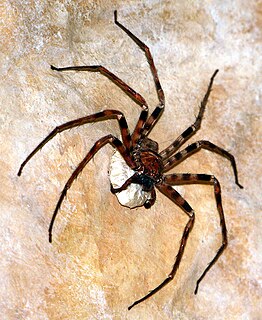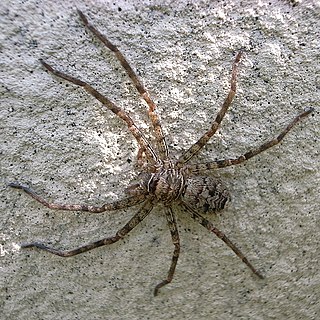
Huntsman spiders, members of the family Sparassidae, are known by this name because of their speed and mode of hunting. They are also called giant crab spiders because of their size and appearance. Larger species sometimes are referred to as wood spiders, because of their preference for woody places. In southern Africa the genus Palystes are known as rain spiders or lizard-eating spiders. Commonly they are confused with baboon spiders from the Mygalomorphae infraorder, which are not closely related.

Delena cancerides, the flat huntsman or social huntsman or Avondale spider, is a large, brown huntsman spider native to Australia. It has been introduced to New Zealand, where it is sometimes known as the Avondale spider as they are commonly found in the suburb of Avondale, Auckland. This was the species used in the beginning of the 2002 movie Spider-Man, a part in Australian movie Napoleon and widely in Arachnophobia, and all films depict them as having a deadly venomous bite, but they are generally considered harmless to humans in real-life. It was first described by Charles Athanase Walckenaer in 1837.

Leucorchestris arenicola, commonly called the dancing white lady spider, is a huntsman spider in the family Sparassidae and genus Leucorchestris. It is commonly found in the Namib desert of Namibia. It is often mistaken with the similarly named Carparachne aureoflava, or more commonly known as the wheel spider from the same location. L. arenicola relies on seismic vibrations, called drumming, for communication. It taps its foremost legs on the sand to send messages to other white lady spiders. Male L. arenicola will travel over 50 m in one night searching for a mate. If they find a mate, they must be extremely careful, for drumming the wrong message can be deadly. One of the major features that characterizes its nocturnal behavior is its specialized vision, using eight eyes in different orientations to capture a panoramic view of the surroundings. L. arenicola spiders use temporal summation in order to be able to see dim lighting during night-time wanderings. The species was first described by Reginald Frederick Lawrence in 1962, who described all the species in the genus Leucorchestris.

Heteropoda venatoria is a species of spider in the family Sparassidae, the huntsman spiders. It is native to the tropical regions of the world, and it is present in some subtropical areas as an introduced species. Its common names include giant crab spider, or cane spider.

Micrommata is a genus of huntsman spiders that was first described by Pierre André Latreille in 1804.

Micrommata virescens, common name green huntsman spider, is a species of huntsman spiders belonging to the family Sparassidae.
Damastes is a genus of East African huntsman spiders that was first described by Eugène Louis Simon in 1880. It is classified under the family Sparassidae, though its subfamilial classification remains unclear. The subspecies Damastes coquereli affinis is a nomen dubium.

The giant huntsman spider, found in Laos, is a species of huntsman spider (Sparassidae), a family of large, fast spiders that actively hunt down prey. It is considered the world's largest spider by leg span, which can reach up to 30 cm (1 ft).
David B. Hirst is an arachnologist previously based at the South Australian Museum in Adelaide. He left the Museum on 22 February 2011. He has described more than 40 species and genera in the huntsman spider family, Sparassidae, and was regularly called on by New Zealand authorities to identify huntsman spiders that entered their country.

Sinopoda forcipata is a species of spider in the family Sparassidae. It was described by Ferdinand Karsch in 1881.
Pleorotus was a monotypic genus of Seychelloise huntsman spiders containing the single species, Pleorotus braueri. It was first described by Eugène Louis Simon in 1898, and was endemic to the Seychelles. The description was based on a single male collected on Mahe Island in 1894, but none have been found in later collections, and it has been declared extinct.
Olios ceylonicus is a species of spider of the genus Olios. It is endemic to Sri Lanka. It is part of the huntsman spider family Sparassidae.
Bhutaniella is a genus of Asian huntsman spiders that was first described by Peter Jäger in 2000.
Quemedice is a genus of South American huntsman spiders that was first described by Cândido Firmino de Mello-Leitão in 1942. As of September 2019 it contains two species, found in Colombia, Argentina, and Brazil: Q. enigmaticus and Q. piracuruca. Originally placed with the Philodromidae, it was moved to the Sparassidae in 2008.
Rhacocnemis is a monotypic genus of Seychelloise huntsman spiders containing the single species, Rhacocnemis guttatus. It was first described by Eugène Louis Simon in 1897, and is endemic to the Seychelles.
Sivalicus is a monotypic genus of Indian huntsman spiders containing the single species, Sivalicus viridis. It was first described by S. Dyal in 1957, and is found in India.
Sparianthis is a monotypic genus of Colombian huntsman spiders containing the single species, Sparianthis granadensis. It was first described by Eugène Louis Simon in 1880, and is found in Colombia.
Stasinoides is a monotypic genus of Ethiopian huntsman spiders containing the single species, Stasinoides aethiopica. It was first described by Lucien Berland in 1922, and is found in Ethiopia. It has only been recorded twice, and is probably misplaced in this family.
Uaiuara is a genus of huntsman spiders that was first described by C. Rheims in 2013.
Nungara is a genus of spiders in the family Sparassidae. It was first described in 2016 by Pinto & Rheims. As of 2017, it contains 3 species from Ecuador and Brazil.








